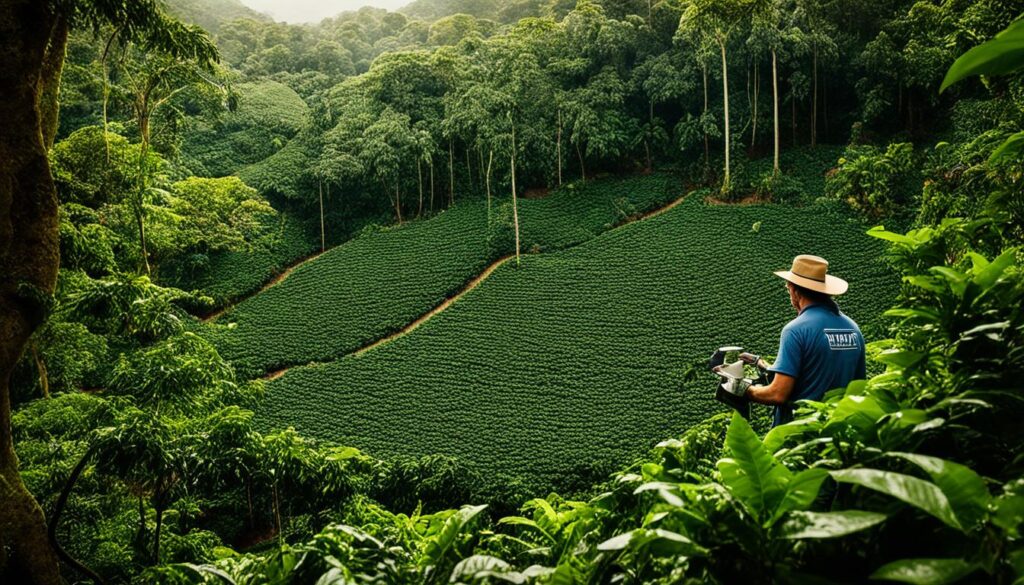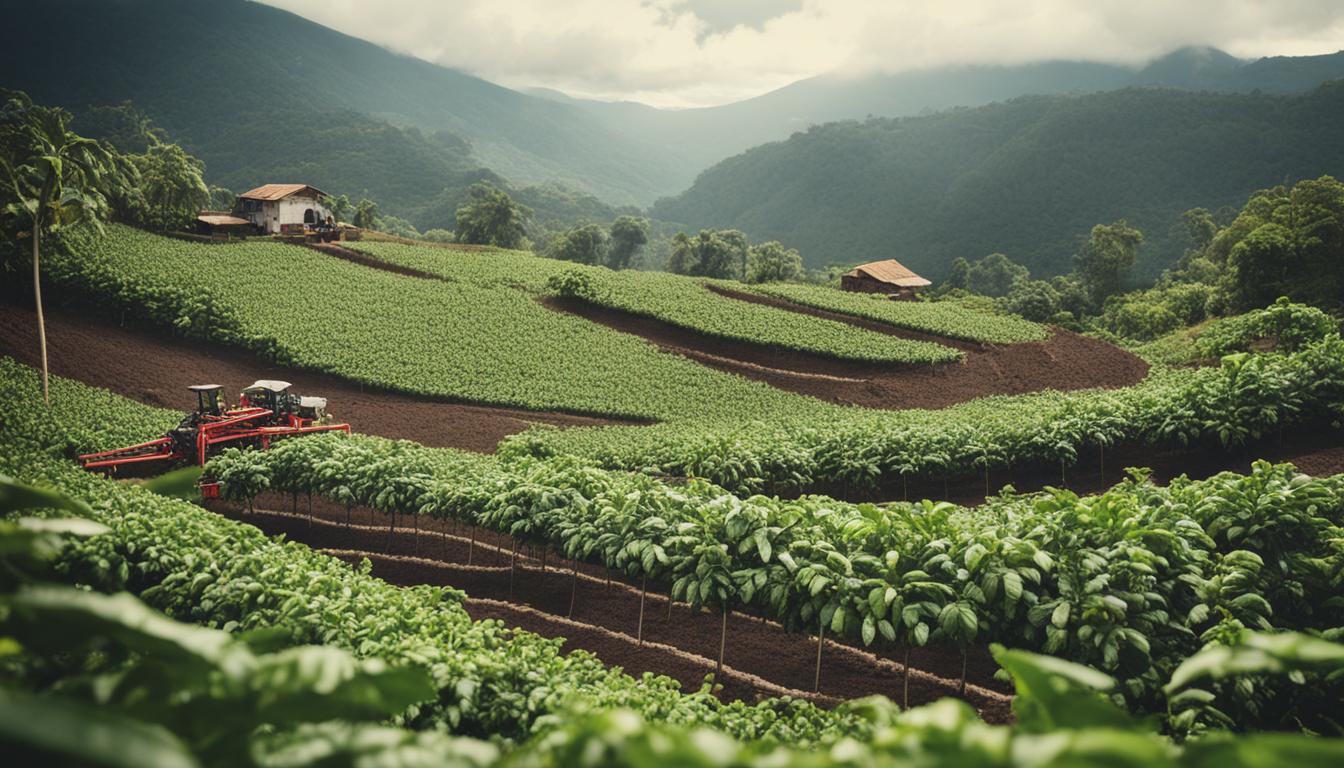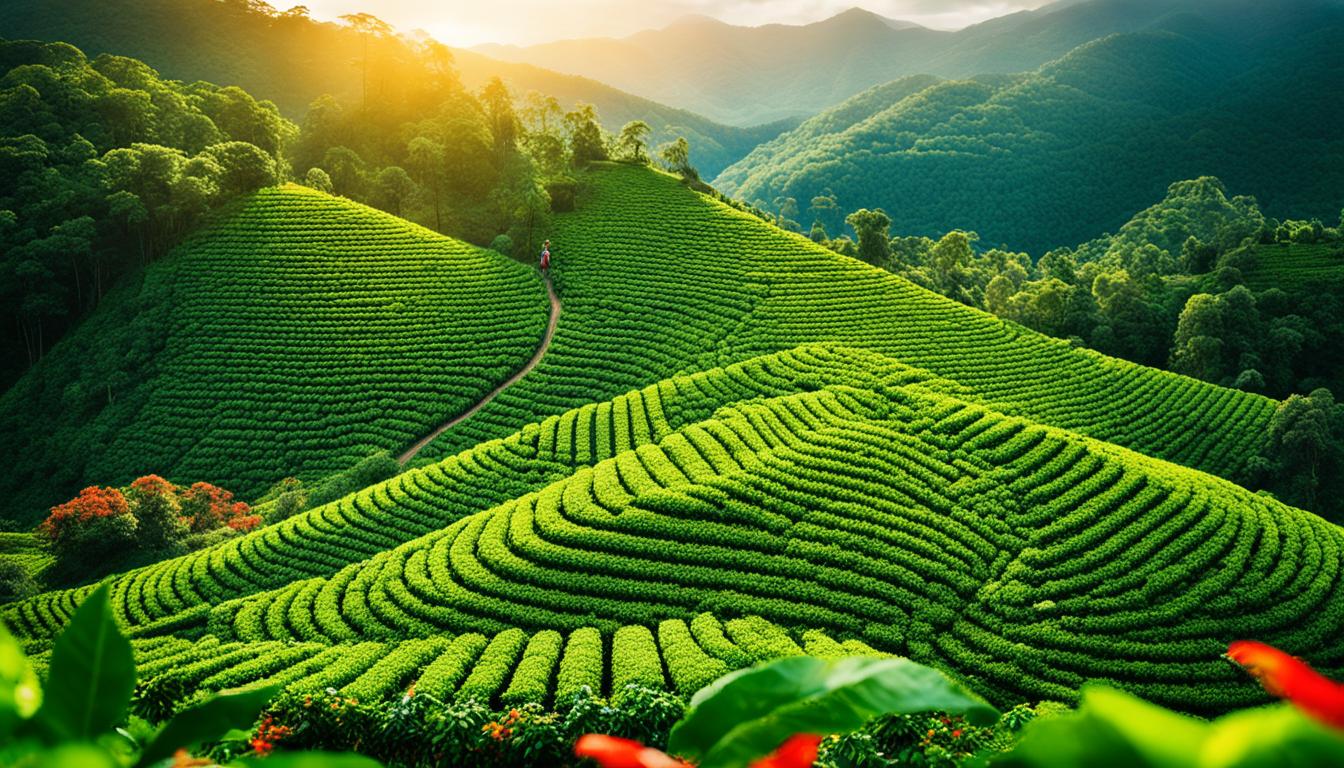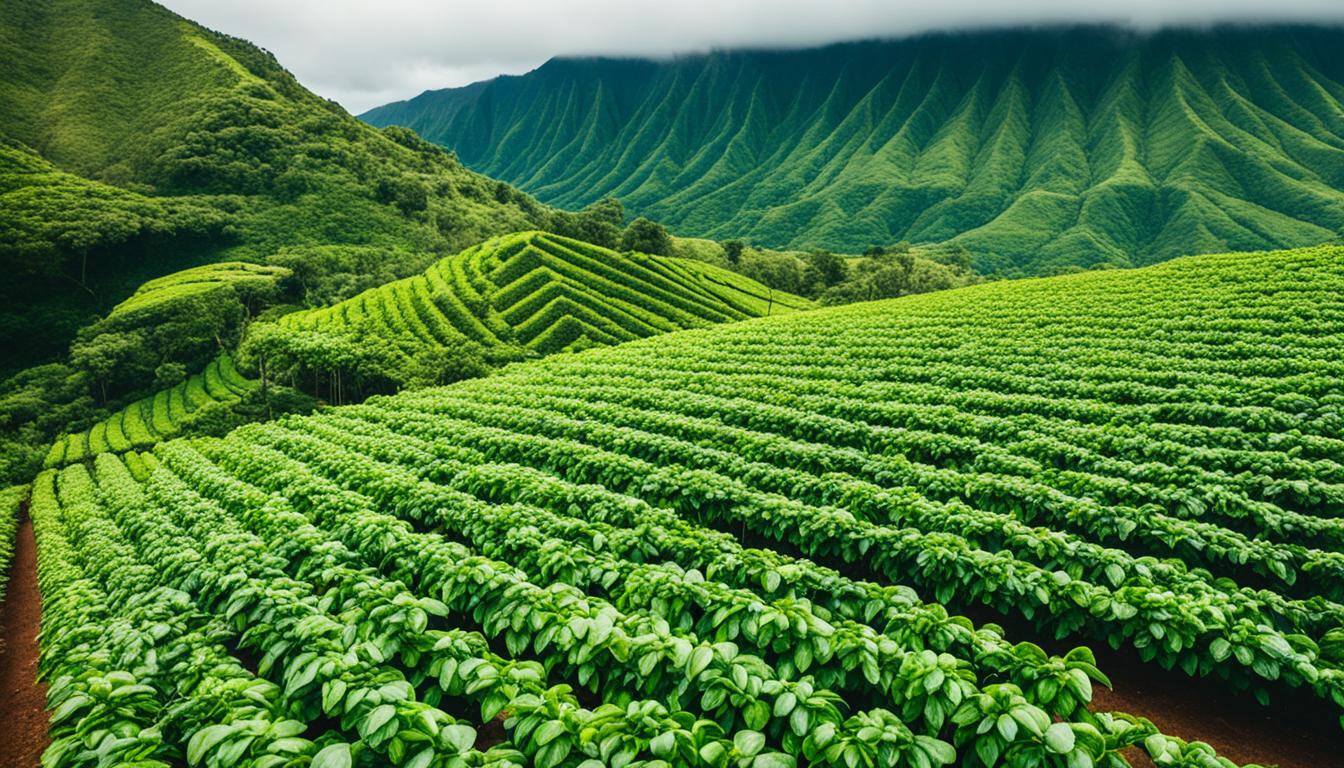Welcome to our exploration of the fascinating history and evolution of coffee farming. From its ancient origins in the coffee forests of Ethiopia to its global presence today, coffee cultivation has seen remarkable transformations over the centuries. Join us as we delve into the rich heritage and remarkable innovations that have shaped the methods of growing this beloved beverage.
Coffee farming has a storied past, originating in the legendary Ethiopian coffee culture and spreading across continents to become a vital part of global trade and social fabric. Over time, technological advancements and sustainable practices have further refined the techniques used to produce coffee beans, ensuring both quality and environmental stewardship.
Key Takeaways:
- Coffee cultivation has a long history and has evolved significantly over time.
- Origins of coffee can be traced back to Ethiopia, where it remains an integral part of the culture.
- Coffee spread and gained popularity across continents, shaping various cultures and economies.
- Advancements in cultivation techniques and technologies have improved productivity and sustainability.
- Modern coffee farming emphasizes sustainable practices, fair trade, and eco-friendly processing.
The Ethiopian Legend: Origins of Coffee
According to an Ethiopian legend, a goat herder named Kaldi discovered the potential of coffee when he noticed that his goats became energetic after eating the berries from a certain tree. Intrigued, Kaldi sampled the berries himself and experienced a newfound sense of vitality. This discovery eventually led to the cultivation of coffee in Ethiopia and the establishment of a deep-rooted coffee culture. Coffee ceremonies, which symbolize hospitality and community, have become an integral part of Ethiopian tradition.
“My goats are spirited after devouring these berries. I must try them myself and see what wonders they hold.”
– Kaldi
Coffee Spreads Across Continents: Global Journey
Coffee cultivation and trade have a rich history that traces back to the Arabian Peninsula. From this region, coffee swiftly spread to different parts of the world, shaping cultures, economies, and the social fabric of nations. Coffeehouses emerged as vibrant hubs of social activity and intellectual exchange, fostering the growth of the coffee trade.
“The art of coffee is woven into the fabric of our society, bringing people together and fueling conversations that transcend borders.”
As the popularity of coffee soared, it reached Europe and became a staple in the coffeehouses of major cities. The appreciation for coffee among the elite contributed to the establishment of coffee plantations in various regions, including the Caribbean and Central America, where the conditions were conducive to its cultivation.
The emergence of European coffee culture brought with it a new wave of coffee enthusiasts. Coffeehouses became the meeting places for intellectuals, artists, and philosophers, who gathered to exchange ideas over a steaming cup of coffee. These establishments played an essential role in fostering intellectual exploration and shaping the cultural landscape of Europe.
Impact on European Society
The introduction of coffeehouses in Europe had a profound impact on society. They provided a space for individuals from different walks of life to engage in lively discussions, debate political and social issues, and share ideas. Coffeehouses became synonymous with intellectual enlightenment and the exchange of knowledge.
Furthermore, the coffee trade led to economic growth and prosperity in European countries. It created opportunities for merchants, fostered international trade networks, and contributed to the development of economic systems.
Coffeehouses fostered the exchange of ideas and played an integral role in the shaping of European society during this period of cultural transformation.
As coffee spread across continents, it became entwined with the fabric of societies, transcending borders and becoming an intrinsic part of daily life. The journey of coffee continues to evolve, with each sip embodying the rich history and vibrant cultures that have embraced this beloved beverage.
Techniques and Technologies: Cultivation Evolution
Over the centuries, coffee cultivation has evolved through the development of innovative techniques and technologies. Through these advancements, coffee farmers have been able to enhance productivity, improve bean quality, and promote sustainability in their practices.
One such technique that has gained popularity in recent years is shade-grown coffee. Unlike traditional sun-grown coffee plantations, shade-grown coffee is cultivated under the canopy of trees, mimicking the natural forest environment. This method not only provides a more favorable habitat for coffee plants but also has positive environmental impacts. The shade provided by the trees helps to regulate temperature, maintain soil moisture, and prevent soil erosion. It also promotes biodiversity by creating a habitat for birds and other wildlife. Additionally, shade-grown coffee beans tend to mature more slowly, resulting in improved flavor profiles and higher quality beans.

Shade-grown coffee cultivation has become increasingly popular among environmentally conscious consumers who value sustainable and responsible farming practices.
Another significant breakthrough in coffee farming technology was the invention of the mechanical coffee pulper. Traditionally, coffee cherries were processed manually, a labor-intensive and time-consuming task. The mechanical coffee pulper revolutionized the harvesting process by automating the removal of the outer skin or pulp from the coffee cherries. This innovation not only significantly reduced the time and labor required for this task but also improved the consistency and efficiency of the process.
Precision agriculture is another technology that has transformed the way coffee is cultivated. By utilizing data-driven decision-making processes, precision agriculture empowers farmers to optimize crop management practices. Through the use of sensors, drones, and advanced analytics, farmers can monitor various factors such as soil moisture, nutrient levels, and pest infestations. This real-time data enables them to make informed decisions about irrigation, fertilization, and pest control, leading to improved crop health and yield.
Advancements in Coffee Cultivation Techniques and Technologies:
| Technique/Technology | Benefits |
|---|---|
| Shade-grown coffee |
|
| Mechanical coffee pulper |
|
| Precision agriculture |
|
These advancements in coffee cultivation techniques and technologies have had a profound impact on the industry. They have not only improved productivity and bean quality but also contributed to the sustainability and environmental stewardship of coffee farming. As coffee cultivation continues to evolve, we can expect further innovations that enhance efficiency, sustainability, and the overall coffee farming experience.
Sustainable Practices and Innovations: Modern Mastery
In recent years, there has been a growing emphasis on sustainable practices and innovative approaches in coffee cultivation. At our coffee farms, we prioritize organic farming methods, agroforestry, fair trade, and eco-friendly processing to ensure the highest quality coffee while promoting environmental stewardship and social responsibility.
Organic Farming for a Healthier Environment
Organic farming is at the heart of our commitment to sustainability. By eschewing synthetic pesticides and chemical fertilizers, we reduce the ecological footprint of coffee production and safeguard the health of our soil, water, and surrounding ecosystems. Instead, we embrace natural solutions such as composting and natural pest control to cultivate coffee beans that are free from harmful residues.
Agroforestry: Nurturing Biodiversity
Agroforestry is a key practice that contributes to the preservation of biodiversity. By integrating trees and shrubs into our coffee farms, we create a harmonious ecosystem that provides shelter and food for birds, insects, and other wildlife. This not only enhances biodiversity but also improves soil fertility and contributes to carbon sequestration, mitigating climate change.
Fair Trade: Empowering Farmers
We believe in fair trade practices that prioritize the well-being of coffee farmers. Through fair trade certification, we ensure that farmers receive fair compensation for their hard work and are able to improve their living conditions. By supporting fair trade, we promote sustainable livelihoods, empowering farmers to invest in their communities and future generations.
Eco-Friendly Processing: Minimizing Waste, Maximizing Efficiency
We are committed to eco-friendly processing methods that minimize waste and reduce the environmental impact of coffee production. By implementing water-saving techniques and exploring innovative wastewater treatment technologies, we minimize water usage and prevent pollution of local waterways. Additionally, we strive to maximize efficiency by repurposing coffee byproducts, such as coffee pulp, as organic fertilizers or biofuel sources.
| Practices | Benefits |
|---|---|
| Organic Farming | Reduces ecological footprint and promotes chemical-free coffee |
| Agroforestry | Enhances biodiversity, improves soil fertility, and sequesters carbon |
| Fair Trade | Ensures fair compensation for farmers, supports sustainable livelihoods |
| Eco-Friendly Processing | Minimizes water usage, reduces waste, and promotes efficiency |
Through these sustainable practices and innovative approaches, we strive to achieve a balance between excellent coffee and environmental responsibility. By choosing our coffee, you not only savor a delicious cup but also support a more sustainable future for coffee farming communities and our planet.
The Third Wave of Coffee: Current Trends
The Third Wave of coffee represents a transformative shift in the way we perceive and experience this beloved beverage. It goes beyond simply consuming coffee for its caffeine content or convenience. Instead, it focuses on treating coffee as a craft or artisanal product, with an emphasis on quality, sustainability, and transparency.
One of the key aspects of the Third Wave movement is the appreciation for specialty coffee. Specialty coffee refers to beans that are carefully cultivated, sourced from specific regions, and roasted to perfection. These coffees showcase unique flavors, aromas, and complexities that can be compared to fine wines or gourmet chocolates. Coffee lovers are now actively seeking out and exploring different specialty coffees, savoring each sip and discovering the diverse nuances of flavor profiles.

Transparency is another critical element of the Third Wave coffee movement. There is a growing demand for transparency within the coffee industry, with consumers wanting to know where their coffee comes from, how it is produced, and the impact it has on the environment and the farmers involved. Companies that embrace transparency provide detailed information about the origin of their beans, the farming practices used, and the partnerships they have with coffee growers. This transparency fosters trust and allows coffee enthusiasts to make more informed choices about the products they consume.
As part of the Third Wave movement, coffee lovers are also encouraged to understand the production process behind their cup of joe. From the cultivation of coffee plants to the harvest, processing, and roasting techniques, there is a wealth of knowledge to be gained. This understanding allows consumers to appreciate the complexity and skill involved in bringing their favorite coffee beans to life. Whether it’s exploring different brewing methods or learning about alternative processing techniques, the Third Wave inspires curiosity and a deeper connection with the coffee-making process.
The Importance of Ethical Sourcing
One of the cornerstones of the Third Wave coffee movement is ethical sourcing. Coffee enthusiasts are increasingly concerned about the social and environmental impact of their coffee consumption. They want to support farmers who receive fair wages, work under safe conditions, and employ sustainable agricultural practices. By prioritizing ethical sourcing, the Third Wave movement aims to create a more equitable and environmentally conscious coffee industry.
“The Third Wave coffee movement represents a shift from simply enjoying a cup of coffee to actively engaging with its origins, production methods, and impact on communities.”
The Third Wave of coffee is not just a passing trend; it’s a paradigm shift in how we engage with this globally beloved beverage. By embracing specialty coffee, transparency, and ethical sourcing, coffee lovers are contributing to a more vibrant and sustainable industry. It’s an exciting time to be a coffee enthusiast, as we discover new flavors, honor the hard work of coffee farmers, and deepen our connection to this beautiful craft.
Conclusion
The coffee industry has undergone a remarkable transformation, driven by the evolution of cultivation methods and changing consumer preferences. From its origins in Ethiopia to its global dominance, coffee farming has adapted and innovated over time to meet the demands of an ever-evolving market.
Through the adoption of innovative techniques and sustainable practices, coffee farmers have not only improved productivity but also embraced their role as environmental stewards. From shade-grown coffee to precision agriculture, the industry continues to prioritize both quality and sustainability.
Looking ahead, the coffee industry is expected to see further advancements in cultivation methods and an increased focus on traceability and quality. Consumers are seeking transparency and are interested in the story behind their cup of coffee – where it comes from, how it’s produced, and the impact it has on communities and the environment.
Coffee remains a beloved beverage that connects people across the globe and reflects the rich tapestry of human history and innovation. As the coffee industry continues to evolve, we can look forward to new trends, emerging technologies, and a deeper appreciation for the craft and culture of coffee.
FAQ
What is the origin of coffee cultivation?
According to an Ethiopian legend, coffee cultivation began when a goat herder named Kaldi discovered the energizing effects of coffee berries.
How did coffee spread across the world?
Coffee trade and the establishment of coffeehouses in Europe played a significant role in spreading the popularity of coffee globally.
What are some innovative techniques in coffee cultivation?
Shade-grown coffee, mechanical coffee pulpers, and precision agriculture technologies are some of the advanced techniques used in coffee farming.
What sustainable practices are used in modern coffee cultivation?
Organic farming, agroforestry systems, fair trade practices, and eco-friendly processing methods are some of the sustainable practices employed in coffee cultivation.
What is the Third Wave of coffee?
The Third Wave of coffee is a current trend that emphasizes the craft, quality, and traceability of coffee, highlighting ethical sourcing and a more immersive coffee experience.
What can we expect in the future of coffee cultivation?
As the coffee industry continues to evolve, we can anticipate further advancements in cultivation methods and an increased focus on traceability, quality, and sustainability.




